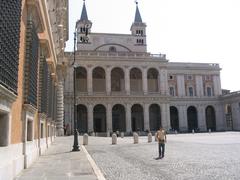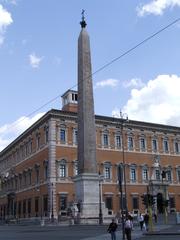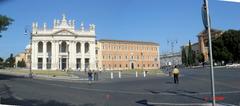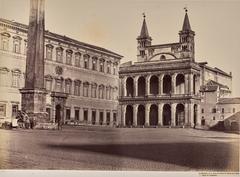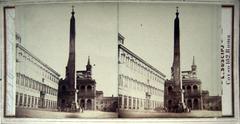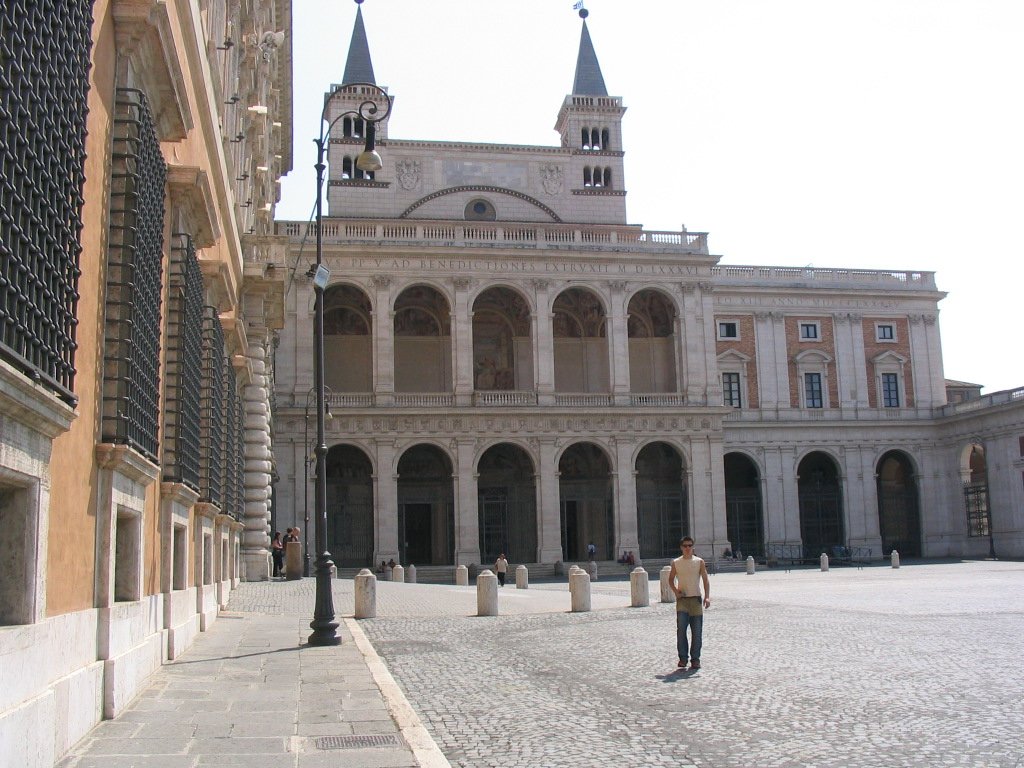
Lateran Palace Visiting Hours, Tickets, and Historical Guide – Rome, Italy
Date: 14/06/2025
Introduction
The Lateran Palace (Palazzo Lateranense) stands as one of Rome’s most significant historical and religious landmarks, reflecting centuries of papal authority, ecclesiastical tradition, and extraordinary architectural evolution. Adjacent to the Archbasilica of St. John Lateran on the Caelian Hill, this former papal residence invites visitors to explore the heart of Catholic history and Roman culture. From its beginnings as a Roman noble estate, its transformation by Emperor Constantine in the 4th century, to pivotal events such as the Lateran Councils and the 1929 Lateran Treaty, the palace is deeply woven into the fabric of church and city history (romesite.com; MyRomePass).
Having undergone extensive restoration, the palace now presents a harmonious blend of Romanesque, Renaissance, and Baroque styles, with grand halls, papal apartments, and sacred spaces such as the Scala Santa. Recent restorations, completed in 2021, have opened the palace to the public, offering guided tours that highlight its spiritual and artistic legacy (palazzolateranense.com; Travel Buddies).
This guide details the Lateran Palace’s rich historical background, architectural highlights, visitor information (including hours, tickets, and accessibility), nearby attractions, and practical tips for a memorable visit—especially during special occasions like the Jubilee Year 2025 (saturdaysinrome.com; traveldudes.com).
Table of Contents
- Introduction
- Historical Overview
- Architectural and Artistic Highlights
- Interior Layout and Notable Spaces
- Artistic Masterpieces
- The Lateran Obelisk and External Features
- Visiting Information: Hours, Tickets, and Accessibility
- Security and Visitor Regulations
- Guided Tours and Accessibility
- Practical Travel Tips
- Nearby Amenities and Services
- Special Considerations During Jubilee Years
- Frequently Asked Questions (FAQ)
- Conclusion
- References
Historical Overview
Origins and Early History
The Lateran Palace’s roots trace back to the Roman Empire, as the estate of the Laterani family. After being confiscated by Emperor Nero, it was eventually granted by Emperor Constantine to Pope Miltiades I in the early 4th century, marking the beginning of its use as the official papal residence. The adjacent Archbasilica of St. John Lateran also became the cathedral of Rome (romesite.com).
Medieval Expansion and Significance
The palace flourished in the Middle Ages, expanded and embellished by popes such as Innocent III and Boniface VIII. It hosted five ecumenical Lateran Councils and numerous imperial coronations, playing a central role in both religious and political realms (saturdaysinrome.com).
Calamities and Decline
Earthquakes in the late 9th century and fires in the 14th century, combined with the papal residence’s relocation to Avignon, led to the palace’s decline. When the popes returned to Rome in 1377, the Vatican Palace became their new residence (myadventuresacrosstheworld.com).
Renaissance and Baroque Rebuilding
Pope Sixtus V commissioned Domenico Fontana to rebuild the palace in the late 16th century, resulting in a Renaissance and Baroque masterpiece. Surviving medieval elements, such as the Leonian Triclinium and Scala Santa, were preserved and incorporated into the new design (Travel Buddies).
Modern Era and the Lateran Treaty
No longer the papal residence, the palace served various roles, including as a hospice and administrative center. In 1929, it became the site of the Lateran Treaty, which established Vatican City’s sovereignty. Today, it houses the Museo Storico Vaticano and church offices (palazzolateranense.com).
Recent Developments and Public Access
After significant restoration completed in 2021, the palace reopened to visitors, offering guided tours of its historic halls, papal apartments, and sacred chapels (palazzolateranense.com).
Architectural and Artistic Highlights
- Leonian Triclinium: A medieval banqueting hall, remnant of the original complex.
- Scala Santa (Holy Stairs): Believed to be the very steps Jesus ascended before Pontius Pilate, brought to Rome by St. Helena.
- Sancta Sanctorum Chapel: The pope’s private chapel, housing revered relics and artworks.
The palace’s interiors are adorned with Renaissance and Baroque frescoes, tapestries, and decorative arts, reflecting the Church’s patronage of artists and architects (MyRomePass).
Interior Layout and Notable Spaces
The Grand Halls
Visitors are guided through a series of ten principal rooms, each with unique historical and artistic features:
- Hall of the Pontiffs: Commemorates the 1929 Lateran Treaty (Civitatis).
- Hall of the Emperors: Showcases the relationship between the papacy and imperial power.
- Hall of Constantine: Depicts the Edict of Milan and Constantine’s influence on Christianity.
- Sala degli Apostoli, Sala Salomone, Sala della Gloria: Feature biblical themes and grand frescoes.
Papal Apartments
Recently renovated, these rooms offer insights into papal daily life and ceremonies, featuring period furnishings and sacred art (Omnia Vatican Rome).
Artistic Masterpieces
- Frescoes: Covering thousands of square meters, the palace’s frescoes depict pivotal moments in church history and biblical narratives (Travel Buddies).
- Baroque Tapestries: Elegant textiles add warmth and grandeur, showcasing centuries of craftsmanship.
- Sculptures and Decorative Arts: Mosaics, sculptures, and ornate ceilings highlight the evolving tastes of successive popes (MyRomePass).
The Lateran Obelisk and External Features
In the piazza before the palace stands the Lateran Obelisk, the tallest in Rome, brought from Egypt in the 4th century as a symbol of the Church’s connection to antiquity (MyRomePass). The complex also includes the world’s oldest baptistery and the Sancta Sanctorum, each with significant architectural and artistic merit (Museos).
Visiting Information: Hours, Tickets, and Accessibility
- Visiting Hours: Generally open Tuesday through Sunday, 9:00 AM–6:00 PM (last entry 5:00 PM). Closed Mondays and select holidays (palazzolateranense.com).
- Tickets: Standard adult admission is around €10–14; discounts for students, seniors, and groups. Guided tours and audio guides are available (Civitatis).
- Booking: Purchase tickets online or at the entrance. Advance booking is strongly recommended, especially during Jubilee Years (romapass.it).
- Accessibility: The palace is mostly wheelchair accessible with ramps and elevators. Some historic areas may pose challenges; contact the visitor center for arrangements.
- How to Get There: Metro Line A (San Giovanni station) is closest, with multiple bus lines stopping nearby (italyscapes.com).
Security and Visitor Regulations
- Security Checks: Expect airport-style screening; large bags and sharp objects are not permitted.
- Dress Code: Modest attire required; shoulders and knees must be covered.
- Photography: Allowed without flash and tripods in most areas. Some chapels may restrict photography (rome.us).
Guided Tours and Accessibility
- Guided Tours: Last 60–90 minutes, available in multiple languages. They include access to grand halls, private apartments, and exclusive chapels (Travel Buddies).
- Accessibility: Elevators and ramps serve most public areas, but some historic sections may have steps or uneven floors. Contact the palace for specific needs.
Practical Travel Tips
- Book Early: Essential during peak seasons and Jubilee Years (traveldudes.com).
- Arrive Early: Mornings are less crowded.
- Combine Visits: Consider combined tickets with the basilica, Scala Santa, and baptistery (rome.us).
- Nearby Amenities: Restrooms, cafés, shops, and luggage storage (off-site) are available.
Special Considerations During Jubilee Years
During Jubilee Years, including 2025, the Lateran Palace experiences increased crowds, heightened security, and special religious events. Book tickets and tours well in advance and allocate extra time for security and entry (traveldudes.com).
Frequently Asked Questions (FAQ)
What are the Lateran Palace opening hours?
9:00 AM–6:00 PM, Tuesday through Sunday. Closed Mondays and certain holidays.
How can I buy tickets?
Purchase online through the official website or at the entrance.
Is the palace wheelchair accessible?
Mostly, with elevators and ramps; some historic areas may have limited access.
Are guided tours available?
Yes, in multiple languages, often including nearby religious sites.
What is the dress code?
Shoulders and knees must be covered.
Visual Resources
Related Articles
- A Guide to Rome’s Archbasilica of Saint John Lateran
- Exploring Rome’s Holy Stairs (Scala Santa)
- Top Historical Sites to Visit in Rome
Summary and Visitor Tips
The Lateran Palace is a testament to Rome’s religious, cultural, and political history. Its restored halls and papal apartments offer unparalleled insight into the evolution of the Catholic Church. Guided tours bring the palace’s history to life, while practical visitor information ensures a smooth and enriching experience. During pilgrimage years like Jubilee 2025, planning ahead is key for a rewarding visit (palazzolateranense.com; traveldudes.com).
Download the Audiala app for curated audio tours and current updates, and immerse yourself in one of Rome’s most treasured landmarks (Audiala).
References
- romesite.com
- MyRomePass
- palazzolateranense.com
- saturdaysinrome.com
- Travel Buddies
- traveldudes.com
- Audiala
- Civitatis
- Omnia Vatican Rome
- italyscapes.com
- rome.us
- romapass.it
- Museos
